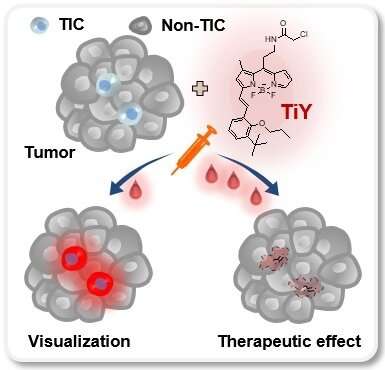This article has been reviewed according to Science X's editorial process and policies. Editors have highlighted the following attributes while ensuring the content's credibility:
fact-checked
trusted source
proofread
Simultaneous diagnosis and treatment of cancer now possible

Cancer is no longer incurable. Nevertheless, according to data released by Statistics Korea last year, cancer remained the primary cause of mortality in Korea in 2021. This highlights the ongoing struggle against cancer, which demands effective prevention measures as well as timely diagnosis and prompt intervention through effective treatment. However, the question remains whether it is feasible to provide treatment promptly upon diagnosis.
A POSTECH research team led by Professor Young Tae Chang (Department of Chemistry) and Research Professor Nam-Young Kang (Department of Convergence IT Engineering) collaborated with researchers at A*STAR in Singapore to determine the ability of fluorescent probe for tumor-initiating cell yellow (TiY) to stain the cells responsible for tumor growth and simultaneously suppress the growth of those cells. The empirical data from the research was published in the journal Theranostics, which covers treatment, diagnosis and personalized medicine.
In their previous study, the research team developed fluorescent probe TiY with the ability to selectively identify and detect tumor-initiating cells (TICs), much like a fluorescent highlighter. Building upon this accomplishment, the team has conducted research aimed at exploring the potential of TiY for cancer treatment.
In the present study, the team observed changes in cancer stem cells in response to different concentrations of TiY. The team obtained cancer stem cells from patients with lung cancer and transplanted them into mice for experimental purposes. In order to evaluate the therapeutic effects of TiY staining, the team gradually increased the dose of TiY administered to the mice via intravenous injection in their tests.
When exposed to a low concentration, TiY has been demonstrated to have the ability to stain cancer stem cells. However, as the concentration of TiY increases, it exhibits the remarkable ability to effectively inhibit the growth of cancer stem cells, leading to their substantial destruction. This selective targeting and treatment are made possible by the mechanism of TiY molecules, which have the capacity to selectively bind themselves to vimentin, a muscle-specific protein that is a component of the cytoskeleton of cancer stem cells, thus allowing TiY to specifically target and inhibit these cells of growth.
Current cancer treatments often fail to achieve complete tumor removal, as cancer cells can be metastasized to other organs or recur. Given the challenge, TiY presents a promising approach to cancer treatment as it can facilitate both diagnosis and treatment in a single step.
More information: Yong-An Lee et al, Theranostics application of tumor-initiating cell probe TiY in non-small cell lung cancer, Theranostics (2023). DOI: 10.7150/thno.79282

















